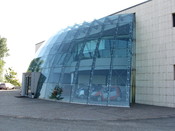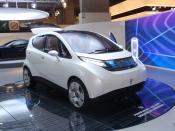Competitive Environment
In the near term, the environment in the European automobile market appears bleak and may result in a shakeout that increases pressure for change on European manufacturers. Many of the changed environmental factors are the direct or indirect result of the superior manufacturing capabilities of Japanese and other non-European firms.
Competitive Environment Bleak
1. The market has grown only slowly in the past two years and is more than 10 per cent below the 1991 high sales. (Exhibit 3).
2. Profit levels are at cyclical lows.
3. Manufacturing capacity utilization is low - around 75 per cent.
European Manufacturer under Pressure
1. Asian competitors have been gaining share at the expense of European producers (Exhibit 3).
2. Japanese "voluntary" export restraints are scheduled to expire soon. In European markets without restraints, Japanese producers have significantly higher share than in markets with restraints.
3. Customer satisfaction levels are generally lower for European manufacturers (Exhibit 4).
4. European producers appear to seriously lag Japanese and American quality and labour efficiency levels (Exhibit 5).
Impact of Manufacturing Capability
1. Improved manufacturing techniques have been responsible for the simultaneously superior quality (internal and external) and superior manufacturing efficiency and costs of non-European producers.
2. ;Increased plant productivity made possible by improved manufacturing contributes to over-capacity problems by getting more production from fewer inputs.
Pininfarina and Niche Producer Position
Niche Producer Advantages
1. Lower fixed costs provide lower overall costs, when volumes are low.
2. Niche producers can respond more effectively to volume fluctuations.
3. Niche producers often bring product and design skills and superior reputations.
Potential Threats to Niche Producers
The spread of more efficient production and producers has raised at least two potentially serious problems for niche producers.
1. Traditional niche manufacturer customers (e.g., Peugeot & Fiat for Pininfarina), who themselves are experiencing considerable erosion of sales, may have less business to offer.
2. Since with the improvement in operational efficiency without major incremental capital investment implies volume production is feasible at lower volumes, the niche business may shrink.
Potential Opportunities for Niche Producers
If niche producers can improve their operational efficiencies more rapidly than European and other volume producers, they can become an increasingly attractive option of lower volumes and might greatly expand their market share. In that sense Pininfarina's improvement in operations to date, as detailed in Exhibit 6, is a step in the right direction.
Potentially, there are still other opportunities created by the changes underway in the European auto industry. Japanese producers have considerably shorter model lives in addition to lower production costs. This suggests that the trend in future will be towards finer market segmentation with shorter-lived models. Such a trend might entail greater volume risks on a given model, or more volatility in seasonal sales levels, and might require greater levels of design effort for a given sales volume. In this scenario, conditions favour the traditional strengths of niche producers - low volume production, flexibility in volume, and highly skilled design. Consistent with this possibility, design revenue at Pininfarina has grown three-fold in three years. Trends in the auto industry towards greater integration of manufacturing and design may also present an opportunity to a niche manufacturer who can master the needed skills.
Pininfarina's Present Position and Strategy
* Recent Operating Performance at Pininfarina
1. Pininfarina is highly dependent on just two models.
2. Pininfarina went through a severe revenue decline in 1992 and 1993, due to a severe drop in production of all vehicles.
3. Revenues have recovered strongly in 1994 and 1995, led by assembled vehicles, and by non-manufacturing revenue such as design services.
4. However, profit rates have not recovered. In 1991 operating income was five per cent of sales, while it was just one percent of sales in 1995, indicating margins of vehicle production remain razor thin.
5. Assembled vehicle revenue as percentage of total vehicle manufacturing revenue has increased from 60 per cent in 1991 to 67 per cent in 1995.
* Present Position in Production
Despite the substantial recent improvements, Pininfarina production operations still lag leading global competitors in quality and productivity levels.
1. Improvements to date still leave Pininfarina short of even U.S. producers after allowance for the eight extra labour hours required by greater handwork.
2. Pininfarina still lags lean producers in quality costs based on the percentage of space devoted to rework and the relatively high percentage of costs devoted to rework (Exhibit 5 and 6).
3. Although Pininfarina's design skills are well known, the case gives little evidence that product and process designs are closely coupled. Product design is physically separate from manufacturing and process design.
4. Since lead times are just over three years for a new model, Pininfarina must find replacement for existing production within the next year to avoid a repeat of 1992-1993's problems.
* Present Strategy and Options
The case suggests the major elements of the current strategy for Pininfarina. The strategy appears to incrementally build on existing strength and continue recent improvements.
1. Acquire a third customer to spread the risk of share loss by one of the existing customers.
2. Leverage design capabilities and brand name to attract niche vehicle prototype business and then win follow-on production manufacturing business.
3. Continue to rely on highly skilled labour to maintain volume flexibility and minimize capital costs.
4. Improve operations within the constraints imposed by labour force and niche volume conditions.
5. Shift production mix from bodies to higher marginal final assembly
In sum, stagnant market growth for automobiles, potential threats to Pininfarina's existing customers by more efficient volume manufacturers, and likelihood that volume manufacturers as a group will improve productivity threaten to make the replacement of existing production volumes more difficult in future for Pininfarina. However, Pininfarina's own improvements to date have greatly improved its competitive position and if continued, could further strengthen it. Other industry trends, such as the tendency to smaller volume models and greater numbers of models, could also benefit Pininfarina. The present strategy appears to be one of incremental change to preserve or extend Pininfarina's position as niche producer.
Positioning Pininfarina for the Future: Evaluating the Options
The Mitsubishi business offers an opportunity to earn a potential modest return, but forces capacity expansion in an already over-capacity market and forces Pininfarina into volume manufacturing, which requires quite different manufacturing and management skills. The potential to rapidly learn needed and transferable skills may provide benefits sufficient to justify the risks and investment.
Current Pininfarina Strategy
Capacity. By adding a third customer, there are no apparent plans to add additional capacity (beyond that implied by productivity improvements) to the over-capacity European auto market.
Equipment and Process Technologies. The current strategy does not appear to contemplate major investment in process technologies.
Vertical integration. There do not appear to be plans to change the scope of work undertaken in-house.
Vendors. Major efforts are underway to improve vendor performance and lower the cost of dealing with suppliers.
New products. Strengths in product design are to be leveraged to try to gain a new customer.
Human resources. Continuation of present efforts appears consistent with the overall strategic direction. Strengths of Pininfarina's operations are the skill and flexibility of its workforce and Pininfarina's ability to match the size of the workforce to current needs for production.
Quality. Although greatly improved, major quality efforts are still likely to be essential for Pininfarina to continue to improve to world-class levels.
Systems. Planning, organizing and scheduling in response to variation appear to be strengths.
1. In the short term, several operational issues are of immediate concern.
Inventory stock-outs should be attacked immediately.
Quality levels still appear well below world-class standards.
Product and process design should be more tightly linked.
2. There are some weakness and uncertainty in current strategy.
Replacement volumes for existing production are not yet in place. What will be done if a third customer is not found?
Will a third customer be able to help Pininfarina improve its operations overall and more rapidly than it could on its own?
Will just one new customer merely replace existing volume or allow the business to grow?
The Mitsubishi Business
1. The financial returns of business are likely to be marginally attractive, depending on the exact levels of capital costs borne by Pininfarina.
The case tells us that total revenue to Pininfarina from the Mitsubishi business is expected to be some 900 billion Lira per year. If the objectives of Mitsubishi contract terms are met, this will leave a profit to Pininfarina of one to two per cent of this total. At 1.5 per cent margin, this would leave 13.5 billion Lira. Against this total revenue must be weighed Pininfarina's investments. Total investment for European production is expected to be 300 billion lira with Pininfarina bearing somewhere 10 and 30 per cent of the cost. Assuming 10% investment, Pininfarina will break even in 30/13.5 or 2.2 years and earn 13.5*5-30=37.5 billion Lira. However, as Pininfarina's required investment increases, the pay-back time increases until it equals the length of the contract at 67.5 billion Lira or about 22.5% of the total, well within the possibility of Pininfarina's capital costs. For example, investment for environmental upgrades in the paint shop could be a considerable fraction of the 100 billion Lira already invested. Still, with levels of investment near 10%, volume guarantees, and some additional margin below target costs, if it can be achieved, the financials would be positive in the near term.
2. However, the Mitsubishi contract will require changes some aspects of Pininfarina's manufacturing strategy.
Capacity. The contract would require more than doubling of capacity in already over-capacity business through the construction of new facilities.
Equipment and Process Technologies. The specialized investment costs for the Pajero will be borne by Mitsubishi. However, it is unclear whether Pininfarina will have to make investments of general nature in equipment and processes that are more appropriate for volume manufacturing. Any such investment will be valuable in the future only to the extent Pininfarina commits itself to volume manufacturing.
Vendors. Many new suppliers unfamiliar to Pininfarina and more distant, but qualified by Mitsubishi, will be introduced. These new suppliers may force additional overhead expense to coordinate activities. The greater distance may also require larger, less frequent shipments - requiring more accurate forecasting and increasing inventories.
New products. The Pajero will make little use of Pininfarina's design skills.
Human resources. New workers will probably have to be hired and trained, particularly since start-up of Pajero production will occur before existing work has completely ramped down.
Quality. Pininfarina will have to introduce both new quality tracking systems and train the workforce in Mitsubishi's on-the-line quality system.
System. The Mitsubishi business will require the management of global supply chains for high value parts such as engines.
3. There are number of short-term implementation risks.
The proposed three-month ramp-up schedule is extremely short given the number of new workers, new suppliers and management and system changes needed.
Pininfarina is vulnerable to delays by Mitsubishi that will leave investments underutilized.
Hiring 600 direct workers with the needed skills and expectations may be challenging.
Ramp-up will occur near the same time that a third customer would, it is hoped, be added, seriously straining management capacity.
Pininfarina may not be able to meet the Mitsubishi quality standards since it will not be precisely reproducing the Mitsubishi process and its workers may not be equivalent.
Pininfarina must be extremely precise to meet or beat the cost targets. Problems with key suppliers could compromise profitability.
4. Longer term, the Mitsubishi business creates substantial risks.
Since Pininfarina is adding capacity in an over-capacity marketplace, it faces the risk that it will not be able to employ the capital.
The addition of semi-fixed workers and fixed assets raises the breakeven volume of the company.
The Mitsubishi business does not solve the problem of how to replace volume in the niche manufacturing business.
5. However, the Mitsubishi business may be managed to maximize learning and move Pininfarina more quickly towards additional organizational skills and manufacturing performance improvements in the niche business as well as create other long-term advantages.
Skills acquired in improving quality in high volume production may be transferable to niche production.
Bertrandi suggests the Mitsubishi business will give Pininfarina a clear view of what its relative manufacturing capabilities are.
Supplier base qualified by Mitsubishi may be an asset for future vehicles.
The contract may lead to follow-on business with Mitsubishi or another strong global auto company.
If capabilities of volume production and demands for quality improvement continue to expand, Pininfarina may have few choices - shrink or become world-class volume producer. The contract may provide a path to building necessary volume produce skills.
CASE UPDATE
Pininfarina accepted the contract essentially as offered and with details still not completely specified. By May of 1997, reports in the financial press suggested Pininfarina had also been selected to manufacture a new Honda Roadster, beginning in 1999.


